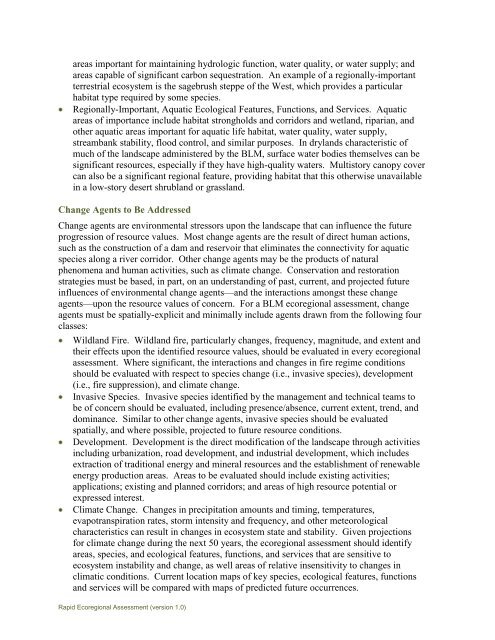BLM's Rapid Ecoregional Assessment - Desert Managers Group
BLM's Rapid Ecoregional Assessment - Desert Managers Group
BLM's Rapid Ecoregional Assessment - Desert Managers Group
Create successful ePaper yourself
Turn your PDF publications into a flip-book with our unique Google optimized e-Paper software.
areas important for maintaining hydrologic function, water quality, or water supply; andareas capable of significant carbon sequestration. An example of a regionally-importantterrestrial ecosystem is the sagebrush steppe of the West, which provides a particularhabitat type required by some species.Regionally-Important, Aquatic Ecological Features, Functions, and Services. Aquaticareas of importance include habitat strongholds and corridors and wetland, riparian, andother aquatic areas important for aquatic life habitat, water quality, water supply,streambank stability, flood control, and similar purposes. In drylands characteristic ofmuch of the landscape administered by the BLM, surface water bodies themselves can besignificant resources, especially if they have high-quality waters. Multistory canopy covercan also be a significant regional feature, providing habitat that this otherwise unavailablein a low-story desert shrubland or grassland.Change Agents to Be AddressedChange agents are environmental stressors upon the landscape that can influence the futureprogression of resource values. Most change agents are the result of direct human actions,such as the construction of a dam and reservoir that eliminates the connectivity for aquaticspecies along a river corridor. Other change agents may be the products of naturalphenomena and human activities, such as climate change. Conservation and restorationstrategies must be based, in part, on an understanding of past, current, and projected futureinfluences of environmental change agents—and the interactions amongst these changeagents—upon the resource values of concern. For a BLM ecoregional assessment, changeagents must be spatially-explicit and minimally include agents drawn from the following fourclasses:Wildland Fire. Wildland fire, particularly changes, frequency, magnitude, and extent andtheir effects upon the identified resource values, should be evaluated in every ecoregionalassessment. Where significant, the interactions and changes in fire regime conditionsshould be evaluated with respect to species change (i.e., invasive species), development(i.e., fire suppression), and climate change.Invasive Species. Invasive species identified by the management and technical teams tobe of concern should be evaluated, including presence/absence, current extent, trend, anddominance. Similar to other change agents, invasive species should be evaluatedspatially, and where possible, projected to future resource conditions.Development. Development is the direct modification of the landscape through activitiesincluding urbanization, road development, and industrial development, which includesextraction of traditional energy and mineral resources and the establishment of renewableenergy production areas. Areas to be evaluated should include existing activities;applications; existing and planned corridors; and areas of high resource potential orexpressed interest.Climate Change. Changes in precipitation amounts and timing, temperatures,evapotranspiration rates, storm intensity and frequency, and other meteorologicalcharacteristics can result in changes in ecosystem state and stability. Given projectionsfor climate change during the next 50 years, the ecoregional assessment should identifyareas, species, and ecological features, functions, and services that are sensitive toecosystem instability and change, as well areas of relative insensitivity to changes inclimatic conditions. Current location maps of key species, ecological features, functionsand services will be compared with maps of predicted future occurrences.<strong>Rapid</strong> <strong>Ecoregional</strong> <strong>Assessment</strong> (version 1.0)
















